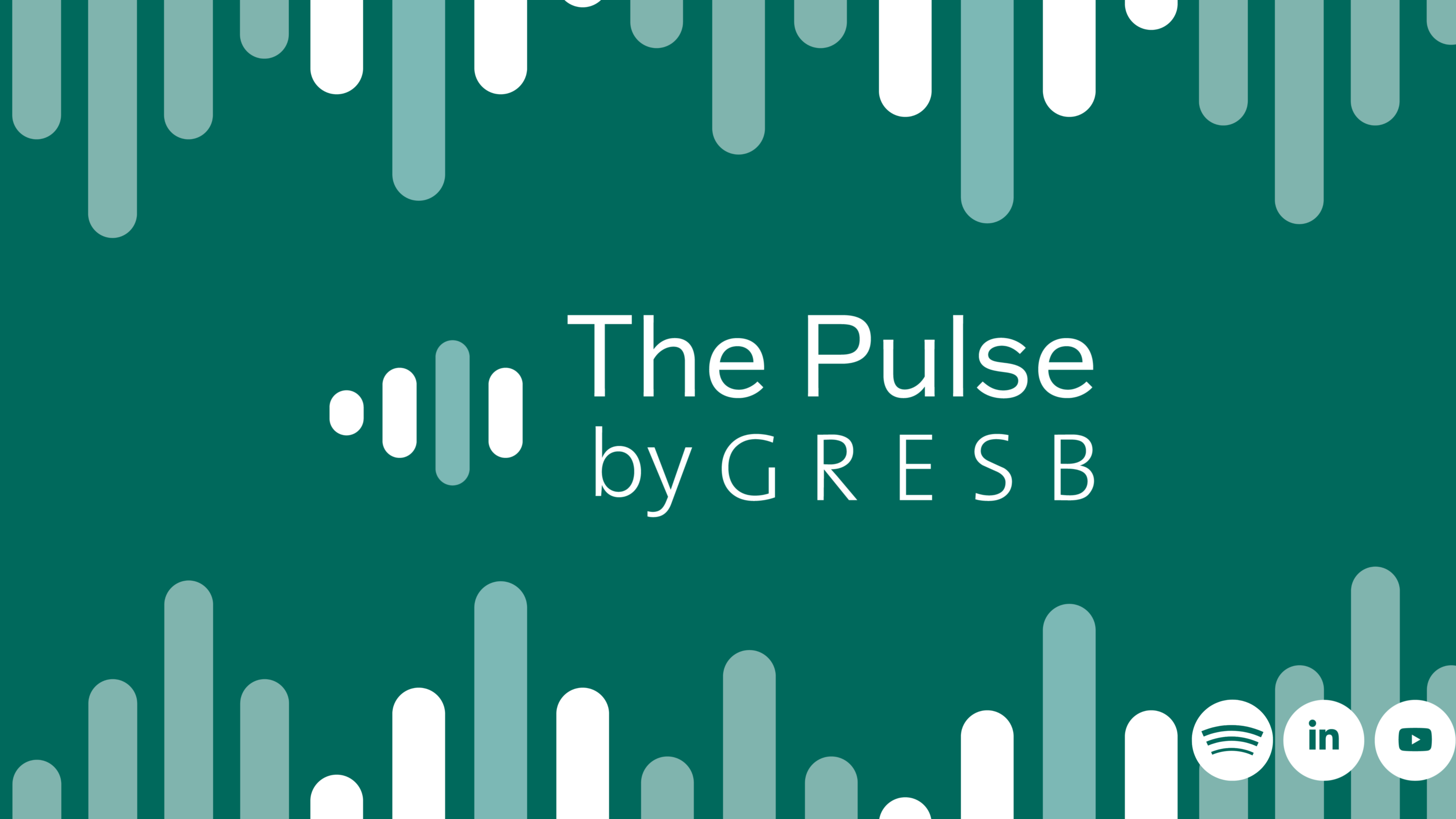
Introducing The Pulse by GRESB
The Pulse by GRESB is an insightful content series featuring the GRESB team, partners, GRESB Foundation members, and other experts. Each episode focuses on an important topic related to either GRESB, ESG issues within real assets industry, decarbonization efforts, or the wider market.
- Watch on Youtube
- Listen on Spotify
- Listen on Apple Podcasts
To peer or not to peer: That is your question
In this episode of The Pulse by GRESB, we bring you a conversation about the new Customized Peer Groups functionality available to GRESB real estate participants. Join our speakers as they discuss how user feedback shaped this feature to enhance participants’ insights and the potential role that the functionality might play in GRESB benchmark reports in the future. Watch the episode below, featuring:
Transcript
Can’t listen? Read the full transcript below. Please note that edits have been made for readability.
Tyler: Hello and welcome to The Pulse by GRESB, our interview series where we discuss important topics in sustainable real assets. Today, I’m your host, Tyler Guthrie, Director of Communications and Marketing at GRESB, and I’m speaking with Christina Djambazca, Product Manager for REAL Solutions. Hi, Christina.
Christina: Hi, Tyler. Thank you for having me today.
Tyler: Thanks for coming on. I am really excited that we are talking about the Customized Peer Group functionality, which is relatively new for our real estate participants. Can you tell me a little bit about what this functionality is and why it’s potentially so useful for those who take advantage of it?
Christina: Yes, of course. So, every October, real estate participants receive their final GRESB results, and they are very excited to see three main insights. This is, of course, the GRESB score, their GRESB star rating, but also their rank within their peer group. In the last couple of years, we have been getting a lot of feedback from our participants on the relevance of their peer group ranking. Mainly, what they say is that this rank doesn’t actually identify who their actual peers are, their investors struggle to understand it quite a lot, and basically they lose a little bit of time having to explain to investors why did GRESB put them in a certain peer group. The reason for that is that we use a standard algorithm to identify the most granular peer group comparison within our GRESB universe, which also changes in size every year. And what participants seem to need more from us is more flexibility. And this is why last year we introduced the Customized Peer Group functionality in test phase. And I’m very happy to be sharing with you today how the results of that went last year and what are we going to be changing this year.
Tyler: Fantastic. Well, let’s dive right in. I would love to understand a little bit about last year’s tests. What were some of the common use cases and what did members actually change?
Christina: Yes, of course. So last year, the functionality was available in August, where participants were able to see their predefined peer group, share with us whether they are happy with it, or they wanted to make some changes, and if they did want to make some changes, they were able to play around with some of the main characteristics that form the peer group, such as its location, its property type, the nature of ownership, and a couple of other criteria that identify their peers. What we saw was that over 700 entities actually used the functionalities, which was a great result for us. And out of the results, what we saw was that there is indeed no apparent way in which our members choose a more fitting comparison. So one of our initial hypotheses was: Is there something wrong with our algorithm?
Do we have to change the standard methodology? Turns out that there is no one way in which we can do this because depending on the property type, the location, or the nature of ownership of the fund, our participants tend to make different customized selections. So, what we saw was that the most frequently tweaked criteria within the peer group was the location, where 52 percent of our members actually change that. And the way in which they change it is not necessarily to be compared against a different country or a different region, but they choose for a less granular location. So, if we have identified a peer group for them that’s based on the country, what they opted for instead was a wider location identification, such as either the sub-region or the region overall. And we saw the same trends with the property type and the nature of ownership as well.
Tyler: That’s really interesting. Can you hypothesize a little bit about what are some of the drivers for someone to want to take a step back to go from, a really granular peer group to something that’s a little bit more regionally focused?
Christina: Yes, of course, I think that the main difference comes from the fact that our predefined peer group methodology stems from the portfolio construction. So what we look at is, where exactly is the majority of the value of the fund in terms of the property type and the location. What our participants seem to try to do when they customize their peer group is to try to adjust it more to the investment reality. So even if we know that the portfolio is mainly located, let’s say, in the Netherlands, what we also know is that investors don’t specifically look for funds based in the Netherlands, but they would compare this Dutch fund against a wider Paneuropean universe. So what our participants were trying to do is to match our methodology, which is rooted in where exactly is the portfolio to how exactly would investors look at it?
Tyler: That makes a lot of sense. can you tell me a little bit about how that may have an impact on the relative ranking within those peer groups? Did we see a shift even if participants were getting to a better overall peer group? Did that affect where they were in that relative ranking?
Christina: Yes, of course. So one of the main things that we were actually a little bit worried about and conscious of when we introduced the functionality last year was, well, wouldn’t participants use that for cherry picking so that they can select a set of criteria that would show that they are first in a peer group when in reality this is not really who their peers are. We were very relieved to see the results, which actually showed that participants rank actually dropped on average compared to the predefined one, which seemed that what they were really trying to do is show or try to identify what exactly is a comparative universe to them, and they weren’t prioritizing making sure that they are first in their peer group, but they were prioritizing making sure that their peer group is accurate.
Tyler: Better insights, better peer groups, better outcomes for investors. That’s great. So you had mentioned 700 participants had taken advantage of this last year. Can you tell me a little bit about what the process has been for developing the feature, what type of user feedback that we’ve taken on, and how did we incorporate that in some of the challenges that our participants were facing going forward?
Christina: We were very happy to actually see that out of the 700 users that used the functionality, over 120 of them provided us with feedback on how they found their experience, what would they want to see more in the future. A majority of the feedback was overwhelmingly positive. And it showed the market’s excitement for more flexibility coming out of GRESB. Aside from this, the main feedback items that we heard from them was on the lack of representativeness of some alternative property types, where, let’s say we just don’t have enough of those in the GRESB universe. So this is not necessarily something that we can fix through the functionality, but we continue to expand the GRESB universe and hopefully in the next years, we will be able to fill in those gaps as well. And in terms of the functionality itself, additional requests that we received included, well, addition of some insights based on the Customized Peer Group in the benchmark report, as well as more flexibility for non-listed entities to be able to, first of all, see who their peers are and be able to select or deselect individual ones based on their fund manager. I’m very happy to say that we were able to incorporate majority of that feedback and users will see those key requests incorporated in the functionality for this year.
Tyler: That’s great to hear. So, I think one thing that stuck out to me reading about the functionality is that this year participants will be able to see two comparisons, one against the GRESB predefined peer group and another against their Customized Peer Group. Can you tell me why this will be an option for them?
Christina: So last year, we allowed participants to play around with the functionality and we provided them with a ranking based on their Customized Peer Group in an offline environment outside of the benchmark report. This year is going to be the first year when investors are actually going to be able to see the output of the Customized Peer Group, and we want to see what their initial reaction is.
So we wanted to make sure that they both have those new insights based on the Customized Peer Group, but we ensure some continuity for investors and we continue to display the predefined ranking as they are used to have seen that in the past. Another reason why we are keeping it is that actually 20 percent of the users that use the functionality confirmed that they are happy with their predefined peer group and didn’t make any amendments. So, there is still those 20 percent plus the other two-thirds of the universe that didn’t use the Customized Peer Group functionality who are happy with our initial methodology and we would want to make sure that they continue to have peer group based insights in the Benchmark Report.
Tyler: Yeah, that makes sense. Giving participants the ability to try it out to see how it might fit and then ultimately decide how they actually want to use it in the future. That’s great. So, speaking of the future, can you tell me a little bit about what role the Customized Peer Group Functionality might play in GRESB benchmark reports and other insights, in the near future?
Christina: Yes, of course, so this year we are only going to be incorporating the Customized Peer Group ranking in the top of the Benchmark Report. Of course, the Benchmark Report is full of peer group based insights that for this year are going to continue to be based on the predefined peer group, but the intent is that based on the feedback that we received this year, we continue to provide more and more of the Customized Peer Group insights throughout the benchmark report so that we can help participants not only explain their results to investors, which is what we hope they are going to be able to do with the rank, but then also use the Customized Peer Group insights for strategy decisions and internal decision making based on what their actual peers are actually doing. We are also seeing that trend throughout all of other products and services that GRESB has to offer and this is the general feedback that we are receiving from the industry, which is that there is a need for more flexibility from GRESB. So participants already know a lot about the GRESB results.
They have gotten more and more capable filling in the GRESB survey and using the insights out of this. But what they want to be able to do now is also put all of those insights into the right context for them. So we can see that with real benchmarks where we allow them to gain more insights into their asset levels in a flexible way. We see that through the better catering for residential portfolios in the real estate standard, and there is more of that flexibility to come in the next couple of years from GRESB.
Tyler: Well, that sounds like a great level of customization for participants. Christina, is there anything else you’d like to say before we wrap up?
Christina: Only one last final thing which is that the Customized Peer Group functionality is going to be available for the first two weeks of August. So if you are a GRESB real estate participant that wants to make use of that functionality this year, please make sure to log in the GRESB portal from the 1st to the 15th of August.
Tyler: Christina, thanks so much for the time and I look forward to seeing how participants use it this year and also receiving more feedback from that experience. Thanks everyone for listening and catch you next time on The Pulse.
Christina: Thank you, Tyler. Thanks, everyone.

